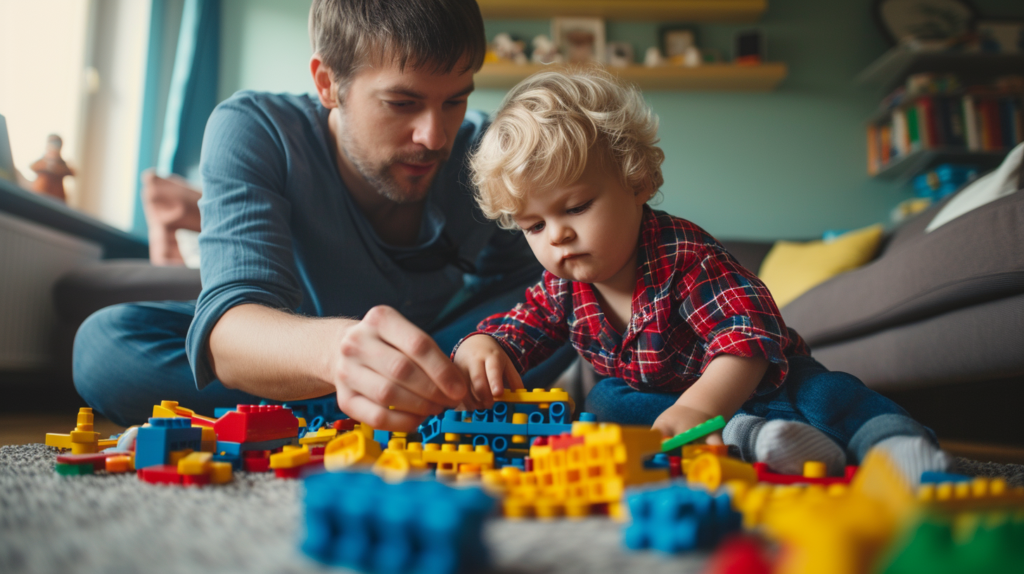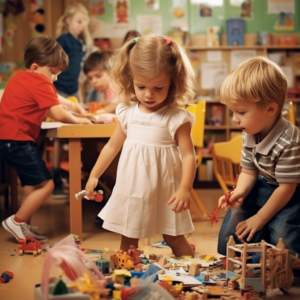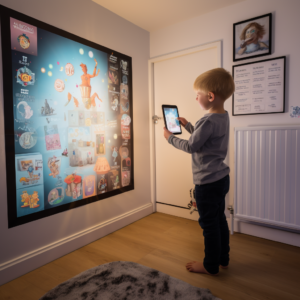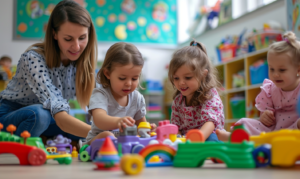As parents and caregivers embark on the remarkable journey of witnessing a child’s early years, understanding developmental milestones becomes a beacon, guiding them through the nuances of growth and development. These milestones, markers of significant progress in a child’s physical, cognitive, emotional, and social development, offer valuable insights into the child’s evolving abilities and needs. However, navigating this journey can sometimes feel overwhelming, given the plethora of information and advice available.
This comprehensive guide is designed to simplify this journey, providing clear, actionable advice and insights into what parents can expect during their child’s early years. By breaking down the developmental milestones into manageable chapters, this guide aims to equip parents with the knowledge and tools they need to support their child’s growth effectively. Through practical tips, illustrative case studies, and best practices, each chapter will delve into the key areas of development, helping parents and caregivers create a nurturing and supportive environment that fosters their child’s potential.
Recognizing that each child is unique, with their own timeline for reaching milestones, this guide also emphasizes the importance of patience, encouragement, and understanding in the developmental process. It’s not just about celebrating the milestones but also about enjoying the journey itself, filled with moments of learning, discovery, and joy. With this guide, parents and caregivers will gain the confidence to support their child’s development with love, understanding, and informed care.

Chapter 1: Physical Development in the Early Years
Physical development in the early years lays the foundation for a child’s ability to explore their world. From the first unsteady steps to the confident run, each milestone represents a leap in physical abilities. This chapter focuses on understanding these milestones, offering advice on how to support your child’s physical development, and sharing a case study to illustrate these concepts in action.
Understanding Physical Milestones
Physical milestones in the early years are broadly categorized into gross motor skills, involving large movements like walking and jumping, and fine motor skills, involving smaller actions like grasping and manipulating objects. By knowing what to expect at different stages, parents can better support their child’s development:
- 0-6 months: Look for milestones such as lifting the head, rolling over, and reaching for objects.
- 6-12 months: Sitting up, crawling, and possibly taking first steps are key developments.
- 1-2 years: Walking independently, running, and starting to climb.
- 2-3 years: Improved coordination, kicking a ball, and beginning to ride tricycles.
Tips for Supporting Physical Development
Supporting your child’s physical development involves creating opportunities for them to practice new skills in a safe and encouraging environment:
- Encourage Floor Time: Ample time on the floor allows babies to practice rolling, crawling, and eventually taking steps.
- Play Together: Engage in activities that encourage your child to move, such as rolling a ball back and forth or playing chase.
- Safe Exploration: Ensure your home is child-proofed, allowing your child to explore freely without unnecessary risks.
- Variety of Toys: Offer toys that encourage different types of physical activities, such as balls, push toys, and simple puzzles for fine motor skills.
Case Study: Jamie’s Journey to Walking
Jamie’s parents were eager for him to start walking. At 12 months, Jamie was still preferring to crawl, showing little interest in standing or walking independently. His parents introduced several strategies to encourage walking:
- Supported Walking: They started by holding Jamie’s hands to help him feel secure while attempting to walk.
- Motivating Toys: A push toy was introduced, which Jamie could hold onto for support while encouraging him to take steps.
- Encouragement and Space: Jamie’s play area was arranged to encourage movement, with toys placed just out of reach to motivate him to move towards them.
By 14 months, Jamie was taking independent steps. By 15 months, he was walking confidently. This case study highlights the importance of patience, the right tools, and creating a supportive environment for physical development.
Best Practices
- Monitor Development: Keep an eye on your child’s progress and consult with a pediatrician if you have concerns about their physical development.
- Encourage, Don’t Pressure: Every child develops at their own pace. Offer encouragement and opportunities for physical activity without pressuring them.
- Safe Environment: Regularly assess your home for potential hazards as your child’s mobility increases.
- Celebrate Milestones: Acknowledge and celebrate each new skill your child masters, reinforcing their confidence and enjoyment in physical activities.
Physical development in the early years is a journey of discovery and growth, not just for the child but for parents and caregivers too. By understanding these milestones and offering the right support, you can help lay a strong foundation for your child’s future physical activities and overall health.

Chapter 2: Cognitive Development and Milestones
Cognitive development in the early years encompasses the growth of thinking, learning, problem-solving, and memory. This chapter delves into the cognitive milestones your child will reach, offering strategies to nurture their cognitive abilities and sharing a case study to bring these strategies to life.
Understanding Cognitive Milestones
Cognitive milestones mark significant steps in a child’s ability to understand and interact with the world around them. These milestones include:
- 0-6 months: Responding to faces and recognizing parents, following moving objects with their eyes, and showing curiosity.
- 6-12 months: Exploring objects through touch, understanding object permanence (knowing that objects continue to exist even when out of sight), and responding to their name.
- 1-2 years: Engaging in pretend play, pointing to objects or pictures when named, and following simple instructions.
- 2-3 years: Sorting objects by shape and color, completing simple puzzles, and understanding more complex instructions.
Tips for Enhancing Cognitive Development
Fostering cognitive development involves engaging your child in activities that stimulate their curiosity and thinking skills:
- Interactive Play: Use toys and everyday objects to play games that encourage your child to solve problems, like hiding toys under blankets to teach object permanence.
- Talking and Listening: Engage in conversations with your child, describing your actions and surroundings, to build their vocabulary and understanding of the world.
- Reading Together: Reading stimulates imagination, enhances vocabulary, and helps develop listening and memory skills. Choose books with colorful pictures and simple stories.
- Encourage Exploration: Allow your child to explore safely, providing a variety of materials like blocks, drawing tools, and puzzles that stimulate different aspects of cognitive development.
Case Study: Aisha’s Problem-Solving Skills
Aisha, at 18 months old, showed an early interest in puzzles. Her parents introduced her to simple puzzles with large pieces that matched specific shapes. Initially, Aisha struggled to find where each piece belonged, but her parents encouraged her by showing her how to match shapes and colors.
They also engaged Aisha in other problem-solving activities, like sorting toys by size and color. These activities were integrated into daily playtime, making learning fun and natural. By the age of 2, Aisha was able to complete puzzles designed for older children, demonstrating advanced problem-solving skills and an understanding of complex shapes and patterns.
This case study illustrates the importance of recognizing and nurturing your child’s interests and abilities, providing them with opportunities to challenge and develop their cognitive skills.
Best Practices
- Create a Stimulating Environment: Surround your child with a variety of stimuli, including books, toys, and interactive games that encourage cognitive development.
- Be Patient and Supportive: Recognize that children learn at their own pace. Celebrate their achievements, and provide gentle guidance when they face challenges.
- Incorporate Learning into Daily Activities: Use everyday moments as opportunities for learning, such as counting steps while walking or identifying colors and objects around the house.
- Limit Screen Time: Encourage activities that require interaction and imagination, as excessive screen time can limit opportunities for active learning and problem-solving.
Cognitive development in the early years sets the foundation for lifelong learning and problem-solving. By understanding these milestones and actively supporting your child’s cognitive growth, you help pave the way for their future academic and personal success.

Emotional and Social Development
Emotional and social development in the early years is crucial for a child’s ability to understand their own feelings, relate to others, and navigate social situations. This chapter explores the milestones within emotional and social development, provides strategies for nurturing these skills, and includes a case study to illustrate practical applications.
Understanding Emotional and Social Milestones
Emotional and social milestones reflect a child’s growing understanding of their emotions and their ability to interact with others. Key developments include:
- 0-6 months: Smiling at familiar faces, using sounds to express joy or displeasure, and calming down with soothing.
- 6-12 months: Developing attachments to parents and familiar caregivers, showing fear of strangers, and enjoying social play.
- 1-2 years: Showing specific preferences for certain people and toys, playing alongside other children (parallel play), and exhibiting signs of empathy.
- 2-3 years: More complex interactions with other children, taking turns, showing a range of emotions, and beginning to understand sharing.
Tips for Supporting Emotional and Social Development
Supporting your child’s emotional and social development involves creating an environment that fosters emotional expression and social interaction:
- Model Positive Behavior: Children learn by watching adults. Demonstrate healthy emotional expressions and positive social interactions.
- Encourage Expression: Let your child know it’s okay to express their feelings and help them label their emotions (e.g., happy, sad, angry).
- Social Interaction: Provide opportunities for your child to interact with peers through playdates or group activities, emphasizing the importance of sharing and cooperation.
- Empathy and Understanding: Teach empathy by acknowledging your child’s feelings and showing them how to recognize and respond to the feelings of others.
Case Study: Luca’s First Friendship
Luca, a two-year-old, initially found it challenging to share his toys during playdates, often leading to frustration and tears. His parents began to work with him on understanding emotions by naming their own feelings and reflecting on Luca’s emotions during various situations. They also arranged regular, short playdates with a consistent group of children to build familiarity and comfort.
During these playdates, Luca’s parents actively encouraged sharing and celebrated moments when Luca and the other children played well together. They introduced cooperative games that required sharing and taking turns, guiding the children through the process.
Over time, Luca became more comfortable with the concept of sharing. He developed a particular friendship with one of the children, Mia, with whom he started to share toys without prompting. This friendship also helped Luca understand and manage his emotions better, as he and Mia would look out for each other’s feelings during their play.
This case study highlights the importance of consistent, guided social interactions and the role of parents in teaching and modeling emotional intelligence and social skills.
Best Practices
- Consistent Routines: Maintain a consistent routine that provides a sense of security and predictability for your child.
- Positive Reinforcement: Praise and reward positive social and emotional behaviors, reinforcing the importance of these actions.
- Safe Environment for Expression: Create a safe, supportive environment where your child feels comfortable expressing their emotions, knowing they won’t be judged or dismissed.
- Teach Problem-Solving: Help your child navigate social conflicts and challenges by guiding them through problem-solving steps, encouraging empathy, and finding mutually acceptable solutions.
Emotional and social development is foundational for building relationships, empathy, and a sense of self. By understanding and supporting these milestones, parents and caregivers can help their children develop the emotional intelligence and social skills necessary for lifelong success and happiness.

Speech and Language Development
Speech and language development is a critical aspect of a child’s early years, enabling them to communicate their needs, thoughts, and feelings. This chapter outlines the milestones in speech and language development, offers advice on how to support this area of growth, and presents a case study to exemplify effective strategies.
Understanding Speech and Language Milestones
Speech and language milestones mark a child’s progress in their ability to understand and use language. These milestones include:
- 0-6 months: Coos and makes pleasure sounds, responds to their name, and begins to babble.
- 6-12 months: Babbling grows more complex, starts to imitate sounds, and may say simple words like “mama” or “dada.”
- 1-2 years: Begins to combine words into simple sentences, follows simple commands, and points to objects when named.
- 2-3 years: Vocabulary expands rapidly, begins to use pronouns (I, you, me), asks simple questions, and sentences become longer and more complex.
Tips for Enhancing Speech and Language Development
Supporting your child’s speech and language development involves engaging in activities that promote verbal expression and comprehension:
- Talk Throughout the Day: Narrate your activities and describe your surroundings to introduce new vocabulary and concepts.
- Read Together: Reading books together not only introduces new words but also helps children understand narrative structure and use their imagination.
- Sing Songs: Singing is not only enjoyable but also introduces rhythm, rhyme, and repetition, which are important for language development.
- Encourage Imitation: Encourage your child to mimic actions, sounds, and words. This playful imitation is a powerful tool for language learning.
Case Study: Ethan’s Expanding Vocabulary
Ethan was a late talker, with a very limited vocabulary at 2 years old. Concerned, his parents began to focus more on activities that promoted speech and language development. They increased their daily reading time, choosing books with simple, repetitive phrases and pointed to and named objects throughout the day.
They also started a routine of singing nursery rhymes together, encouraging Ethan to try and mimic the sounds and words. Additionally, they engaged Ethan in conversations, asking him simple questions and waiting patiently for his attempts to respond, even if the responses were not clear words initially.
Within a few months, Ethan’s vocabulary began to expand. He started using more words daily and even began to combine two words to express his needs, such as “more juice” or “big truck.” His parents’ dedicated efforts to immerse him in a rich language environment played a crucial role in his rapid language development.
Best Practices
- Be Patient and Responsive: Engage with your child’s attempts to communicate, even if their words are not clear. Encourage their efforts to foster confidence and motivation.
- Use Technology Wisely: While certain educational programs and apps can support language development, interactive, face-to-face communication is irreplaceable.
- Create a Language-rich Environment: Surround your child with books, songs, and opportunities for conversations to immerse them in a world of words.
- Seek Professional Advice if Needed: If you’re concerned about your child’s speech and language development, consult with a healthcare provider or speech-language pathologist for personalized guidance.
Speech and language development is essential for effective communication and lays the foundation for future reading and writing skills. By understanding these milestones and actively supporting your child’s language abilities, you help open the door to a world of expression and understanding, setting the stage for lifelong learning and connection.
Final Say: Empowering Your Child’s Journey Through Early Development
The early years of a child’s life are filled with remarkable growth and transformation. As we’ve explored through the chapters on physical, cognitive, emotional, social, and speech and language development, each milestone is a step toward greater independence and understanding. The journey through these milestones is not just about reaching developmental checkpoints; it’s about nurturing a well-rounded individual capable of navigating the world with confidence and curiosity.
Understanding these milestones provides a roadmap for parents and caregivers, but it’s crucial to remember that each child is unique, with their own pace of development. Comparison can be a thief of joy; instead, celebrate each achievement, no matter when it occurs. Your support, encouragement, and understanding are the most significant contributions to your child’s growth.
Creating a nurturing environment that promotes exploration and learning, while also providing the security and love children need, is the best practice. This involves being responsive to their needs, offering opportunities for them to learn and grow, and being there to guide them through their successes and challenges.
The case studies presented in each chapter underscore the importance of tailored approaches that consider the individual child’s interests, strengths, and areas for growth. Whether it’s encouraging physical activity, fostering cognitive skills, nurturing emotional intelligence, facilitating social interactions, or enhancing speech and language development, the strategies outlined are designed to empower parents and caregivers in their vital role.
As you continue on this journey with your child, remember that you’re not alone. Seek out resources, support from your community, and professional advice when needed. The early years are a foundation for future development, and your involvement has a profound impact on your child’s path to becoming a resilient, capable, and compassionate individual.
In closing, cherish these early years and the incredible journey of growth and discovery they represent for both you and your child. By understanding and supporting their development, you’re not only helping them achieve milestones but also laying the groundwork for a lifetime of learning, happiness, and success.













